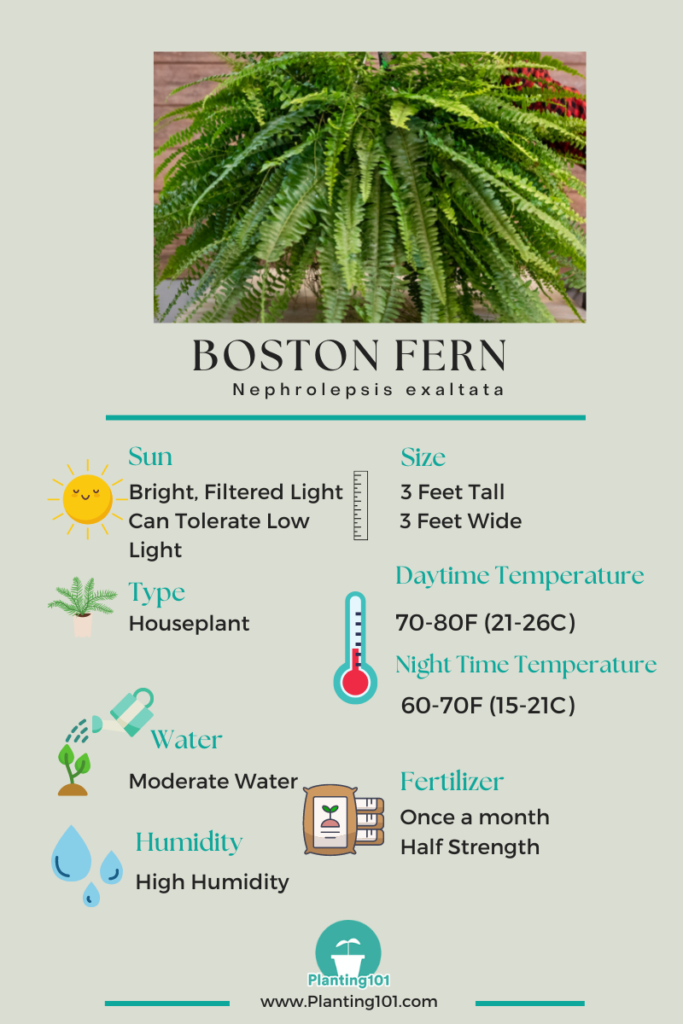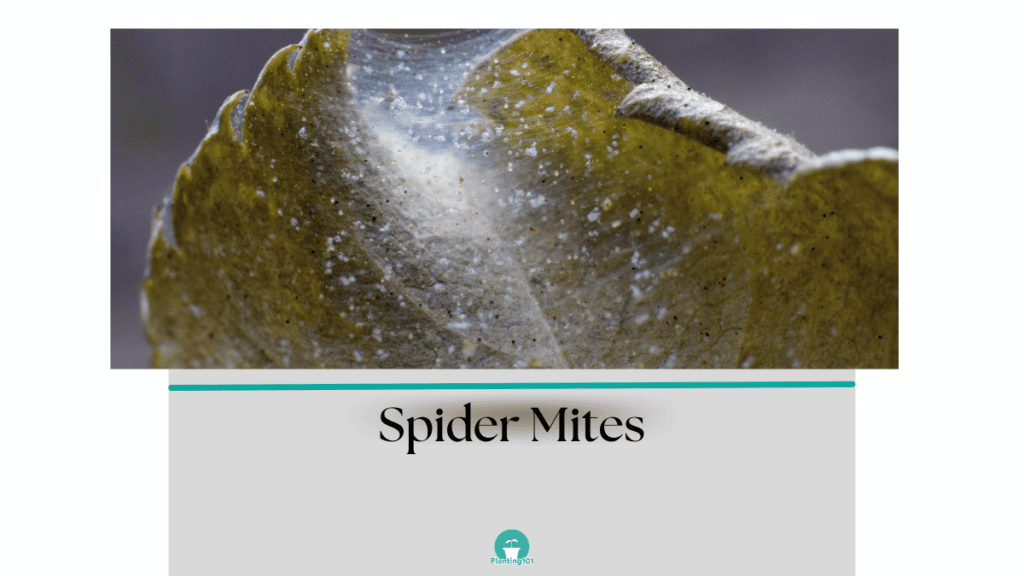Boston Fern (Nephrolepsis exaltata) is a fast-growing fern. It is an attractive, easy-to-care-for houseplant. It’s been a popular houseplant since the Victorian times sought after for its beautiful classic fern leaves. Boston Fern is a humid-loving plant and will do well in bathrooms and other humid spaces. Here are tips on how to take care of your Boston Fern indoors.

Boston Fern Infographic

Boston Fern Basics
| Name | Boston Fern |
| Scientific Name | Nephrolepsis exaltata |
| Care Level | Easy |
| Light | Bright indirect light |
| Daytime Temperature | 70 to 80 F (21-26C) |
| Night Time Temperature | 60 to 70 F (15-21C) |
| Water | Moderate Water |
| Humidity | Medium Humidity |
| Potting | Well-draining, organic, all-purpose potting mix |
| Fertilizer | Once a month at half strength during the growing season |
Boston Fern: Other Names
Boston Fern is also called Boston Swordfern, Fishbone Fern, Wild Boston Fern, and Tuber Ladder Fern.
Boston Fern: Varieties
Nephrolepsis exaltata ‘Rooseveltii’- large Boston Fern variety
Nephrolepsis exaltata ‘Rooseveltii Plumosa’– large Boston Fern variety with curly fronds
Nephrolepsis exaltata ‘Boston Dwarf’- small Boston Fern variety
Nephrolepsis exaltata ‘Teddy Junior’- an adaptable Boston Fern variety
Nephrolepsis exaltata ‘Barnstedt’– leaf tip is rounded
Boston Fern: Size
Boston Fern is a houseplant that can grow to 3 feet tall and wide.
Light
Boston Fern: Sun or Shade?
Boston Fern grows best in bright, indirect light. It will thrive at a South facing window but make sure to filter the sun with sheer curtains. Don’t let it get direct sunlight.
Water
How Often Should You Water Your Boston Fern?
Water your Boston Fern when the soil feels dry. The best way to tell when it is time to water your Boston Fern is to feel the soil. Stick your finger in the soil 1 inch deep. If the soil feels dry, it’s time to water your Boston Fern.
Boston Fern needs constant moisture. Don’t let the soil completely dry out otherwise the leaves will start to drop.
What Type of Water Should You Use When Watering Your Boston Fern?
Your Boston Fern can be watered with tap water but be mindful of the water temperature that you are using to water your Boston Fern. Don’t use straight cold water from the tap to water your Boston Fern. Boston Fern prefers lukewarm water that is not hot and not cold.
When you turn on the cold water from the faucet add a little bit of warm water. You can also get to this ideal temperature by filling a watering can or pitcher with water and leaving it out overnight until the water is at room temperature.
How Do You Make Sure There is Proper Drainage for Your Boston Fern?
Your Boston Fern Good drainage is important, you don’t want your Boston Fern to sit in soggy soil. Make sure there are drainage holes at the bottom of the pot. After watering your Boston Fern and you see water draining out of the pot’s drainage holes, make sure you empty out the accumulated water in the saucer. Don’t let your Boston Fern’s pot sit in this puddle of water. It will cause root rot!
Do You Need to Mist Your Boston Fern?
Your Boston Fern is a houseplant that like humidity. You should increase indoor humidity. Mist your Boston Fern twice a week. Turn on the humidifier. Keep Boston Fern in a saucer filled with water. But make sure the pot is elevated with pot feet or pebbles so your Boston Fern is not sitting directly on the water. You can also keep your Boston Fern in a room with high humidity such as a bathroom.
Soil
What Type of Potting Mix is Best for Your Boston Fern?
Your Boston Fern needs a well-draining, organic potting mix.
How Do You Know When To Repot Your Boston Fern?
Repot your Boston Fern once a year in the summer. Repot your Boston Fern in a container with a diameter 2 inches larger than the current pot.
Fertilizer
Do You Need to Fertilize Your Boston Fern?
Your Boston Fern should be fertilized at half strength once a month during the growing season.
What Fertilizer Should You Use on Your Boston Fern?
Use liquid or powder, organic fertilizer with a higher ratio of nitrogen on your Boston Fern.
Propagation
How Do You Propagate Your Boston Fern?
Your Boston Fern is easy to propagate. You can propagate your Boston Fern by division of its rhizomes. Below are steps on how to propagate Boston Fern by dividing its rhizomes.
1. Dig Up your Boston Fern
Using a hand shovel, dig up your Boston Fern. Then lift out the entire plant. Be careful, don’t damage the roots and rhizomes. Dig a few inches away from the plant.
2. Divide the Rhizomes
Carefully divide up the rhizomes of your Boston Fern.
3. Plant the Rhizomes in a New Pot
Plant each rhizome into a new pot. Don’t plant the rhizomes too close together. Ideally, plant each one in its own pot. Water the new plant immediately after planting. Then water every 2-3 days until the roots are established.
4. Place New Boston Fern in a Spot with Bright Indirect Sun
Place your new Boston Fern in a spot with bright indirect sunlight. Don’t put it in direct sunlight. Keep your Boston Fern in a spot that is warm and humid.
Common Problems of Boston Fern Care
The most common problems that affect Boston Fern are spider mites and yellowing leaves.
Problem: Yellow and Brown Spots with Spider-Like Webs on Leaves and Stems
Boston Fern Problem: There are yellow and brown spots on the leaves of your Boston Fern. You also see spider web-like webbing on the leaves and stems.

Cause: The spider webbing and yellow and brown spots are signs of spider mites attacking your Boston Fern. Spider mites are tiny pests that are too small to see with your bare eyes.
Solution: To treat spider mites on your Boston Fern, spray off the leaves with water from a garden hose. The force will cause the little spider mites to wash off the leaves. You can also wash mites off with soapy water or rubbing alcohol. There are also horticultural oils and insecticidal soaps that you can use to kill off spider mites.
Check out our article on how to make your own homemade pesticides using baby shampoo: How to Make Horticultural Oil and How to Make Insecticidal Soap
Boston Fern: Yellowing leaves
Boston Fern Problem: If you see yellowing leaves on your Boston Fern, that is a sign that something is wrong.
Cause: If you see yellowing leaves with black dots then it could be a fungal infection. Yellow leaves can also be a sign of nutrient deficiency. Yellowing leaves can also be caused by hot, afternoon sunlight or overwatering.
Solution: Check to see if your Boston Fern is being overwatered or placed where there is hot, afternoon sun. If so, move your Boston Fern and decrease watering. Also check to see if there is nutrient deficiency, if so, it’s time to fertilize your Boston Fern.
You May Also Be interested in these Hanging Houseplants
How to Care for your Pothos (Epipremnum aureum)
How to Care for your Satin Pothos
How to Care for your Heartleaf Philodendron
How to Care for Your String of Pearls Plant
How to Take Care of Your Boston Fern (Nephrolepsis exaltata)
Planting 101 participates in affiliate programs including Amazon Associates Program and may earn commission from qualifying purchases at no extra cost to you. Thank you for your support.

